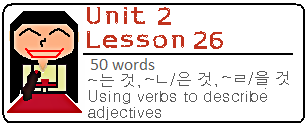 Lesson 26: You have known for a long time how to describe nouns with adjectives. In this lesson, you will be introduced to the very important ~는 것 principle. Using this, you will be able to describe nouns with verbs – as in “the man who is running.” Pay attention, because the concepts you learn in this lesson will be the base for the next 5 – 6 lessons! Lesson 26: You have known for a long time how to describe nouns with adjectives. In this lesson, you will be introduced to the very important ~는 것 principle. Using this, you will be able to describe nouns with verbs – as in “the man who is running.” Pay attention, because the concepts you learn in this lesson will be the base for the next 5 – 6 lessons!
This Lesson is also available in Deutsch, Русский, Suomi, Español, Français, Português, Nederlands and العربية |
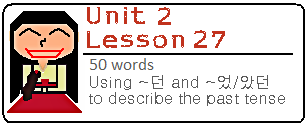 Lesson 27: In this lesson, you will add to what you learned in Lesson 26 by learning more about the ~는 것 principle. Specifically, you will learn about how to use ~던/었던 to describe nouns in the past tense using verbs and adjectives. You will also see how these can be similar to ~은 것. Lesson 27: In this lesson, you will add to what you learned in Lesson 26 by learning more about the ~는 것 principle. Specifically, you will learn about how to use ~던/었던 to describe nouns in the past tense using verbs and adjectives. You will also see how these can be similar to ~은 것.
This Lesson is also available in Русский, Español, Français, Português, Deutsch and العربية |
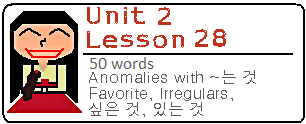 Lesson 28: In this lesson, you will learn a lot of weird things about ~는 것 that don’t really make sense. Here, you will learn thing that are counter-intuitive, but still very important to know about this principle. For example, you will learn about irregular conjugations, saying “my favorite thing” and other small things that you wouldn’t expect. Lesson 28: In this lesson, you will learn a lot of weird things about ~는 것 that don’t really make sense. Here, you will learn thing that are counter-intuitive, but still very important to know about this principle. For example, you will learn about irregular conjugations, saying “my favorite thing” and other small things that you wouldn’t expect.
This Lesson is also available in Русский, Español, Français, Português, Deutsch and العربية |
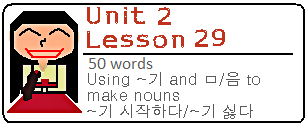 Lesson 29: In this lesson, you will learn how to use ~기 and ~ㅁ/음 to make nouns from verbs or adjectives. These work very similarly to the ~는 것 principle, but there are some differences you should be aware of. Lesson 29: In this lesson, you will learn how to use ~기 and ~ㅁ/음 to make nouns from verbs or adjectives. These work very similarly to the ~는 것 principle, but there are some differences you should be aware of.
This Lesson is also available in Русский, Español, Français, Português, Deutsch, Nederlands and العربية |
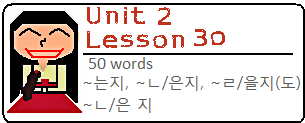 Lesson 30: In this lesson, you will learn how to add ~는지, ~ㄴ/은지 and ~ㄹ/을지(도) to sentences to express uncertainty. Then, you will learn how to indicate that you have been doing something for a certain amount of time. Lesson 30: In this lesson, you will learn how to add ~는지, ~ㄴ/은지 and ~ㄹ/을지(도) to sentences to express uncertainty. Then, you will learn how to indicate that you have been doing something for a certain amount of time.
This Lesson is also available in Русский, Español, Français, Português, Deutsch, 中文 and العربية |
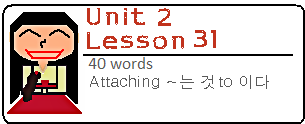 Lesson 31: In previous lessons, you learned how to add ~는 것 to verbs (and adjectives). In this lesson, you will learn about how to apply ~는 것 to 이다. Lesson 31: In previous lessons, you learned how to add ~는 것 to verbs (and adjectives). In this lesson, you will learn about how to apply ~는 것 to 이다.
This Lesson is also available in Español, Русский, Français, Português, Deutsch, 中文 and العربية |
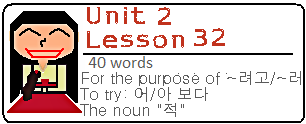 Lesson 32: In this lesson, you will learn about how to use ~려고 and ~러 in sentences to have the meaning of “for the purpose of/in order to.” You will also learn how to add ~어/아 보다 to verbs to have the meaning of “attempt/try to,” which is often used with the noun ‘적.’ Lesson 32: In this lesson, you will learn about how to use ~려고 and ~러 in sentences to have the meaning of “for the purpose of/in order to.” You will also learn how to add ~어/아 보다 to verbs to have the meaning of “attempt/try to,” which is often used with the noun ‘적.’
This Lesson is also available in Español, Русский, Português, Deutsch, 中文 and العربية |
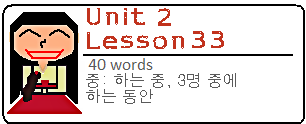 Lesson 33: In this lesson, you will learn two common ways to use the noun ‘중’ in Korean. You will learn how to place 중 after a verb with ~는 것 to have the meaning of “I am ___ing.” You will also learn how to place it after multiple nouns to have the meaning of “..of all ___.” Lesson 33: In this lesson, you will learn two common ways to use the noun ‘중’ in Korean. You will learn how to place 중 after a verb with ~는 것 to have the meaning of “I am ___ing.” You will also learn how to place it after multiple nouns to have the meaning of “..of all ___.”
This Lesson is also available in Español, Русский, Deutsch, Português, 中文 and العربية |
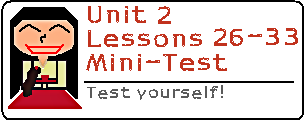 Lessons 26 – 33 Mini Test: Test yourself on what you learned from Lessons 26 to 33! A Mini-Test like this will be uploaded after every eight lessons. Don’t worry if the test doesn’t go so well – this website is here to help you! Lessons 26 – 33 Mini Test: Test yourself on what you learned from Lessons 26 to 33! A Mini-Test like this will be uploaded after every eight lessons. Don’t worry if the test doesn’t go so well – this website is here to help you!
This Mini-Test is also available in Español, Русский, Deutsch, 中文 and العربية |

